Process of making Japanese knives(Kata-ba-haganetuki-houcho)
1) Heating process
| 1.Hagane-kiri |
| 1. The blade steel is shaped and cut it into the correct amount for the knife. |
| 2.Hagane-tuke |
| 2. The blade steel is joined with base steel using
Kinsetsuzai or special bond |
| 3.Wakashi-tuke |
| 3. It is heated to between 800C - 900C for temporary adhesion |
| 4.Sakinobashi |
| 4. The part which is going to be the top of knife is shaped |
| 5.Nakago-nobashi |
| 5. The part of the end of the blade is shaped |
| 6.sou-hidukuri |
| 6. It is heated to make the final shape of the knife |
| 7.yaki-namashi |
| 7. It is then put in ash to cool down slowly avoiding any irregularities |
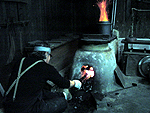
2) Finishing process
| 8.Beto-tori |
| 8. The oxidized film or oxidized iron produced through
heating process is removed |
| 9.Aratataki |
| 9. The knife is on normal temperature to make it tighten |
| 10.uramigaki |
| 10. The face of the blade is polished |
| 11.ji-tachi |
| 11. Extra steel after hit is cut off |
| 12.Hon-narashi |
| 12. The back is pounded to make the quality perfect |
| 13.Kokuin-uchi |
| 13. The maker's name is stamped on the blade |
| 14.Kei-biki |
| 14. The knife is put on the template to mark the correct size |
| 15.Kata-tachi |
| 15. The excess is cut off to make it into the required shape |
| 16.Migari-mawashi |
| 16. The rough edges are polished off with grinder or file |
| 17.Mae-shori |
| 17. All oil or dirt is removed from the blace |
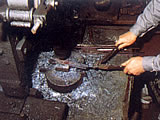
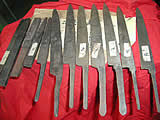
3) Annealing
| 18.Doro-nuri |
| 18. Mud is put on the front to avoid oxidization and irregularities |
| 19.Yakiire |
| 19. It is heated up to 800C and cool down in water |
| 20.Yakimodoshi |
| 20. The same process is repeated to make the blade stronger |
| 21.Hizumi-uchi |
| 21. Irrgularities that may have happened through this process are adjusted |
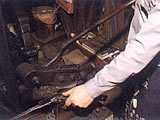
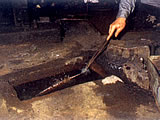
4) Polishing
| 22.Aragiri-hatogi |
| 22. The blade on its front is polished with round roundpolish stone |
| 23.Ara-hira-togi |
| 23. The whold front is polished |
| 24.Ara-ura-togi |
| 24. The back is polished |
| 25.Ara-mune-togi |
| 25. All through from the top to the end of blade is polished |
| 26.Hizumi-togi |
| 26. Irregularities happened polishing process are ajusted |
| 27.Nakame-togi |
| 27. It is polished with smoother stones |
| 28.Hafu-migaki |
| 28. It is then polished with a cloth glued with diamond powder |
| 29.Kito-shiage |
| 29. Diamond powder is put on the woden board to make line |
| 30.Kesyou-shiage |
| 30. It is polished with whetstone powder to get the color |
| 31.Kobatuki-shiage |
| 31. Then next it is polished the top delicately |
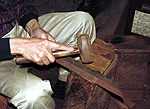 |
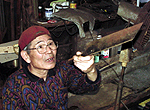 |
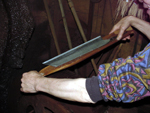 |
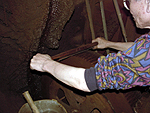 |
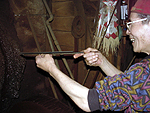 |
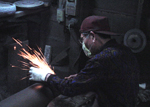 |
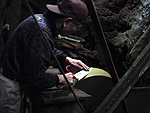 |
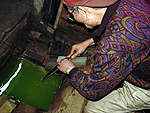 |
 |
@ |
5)Making the handle
| 32.Genboku-kezuri |
| 32. A dried piece of wood is curved into a correct size |
| 33.Kiwa-tuke |
| 33. Then it is curved the part for a ring |
| 34.Ana-ake |
| 34. A hole is made for the haft |
| 35.Wa-hame |
| 35. Baffalo's horn is cut into the same size of the
ring and pushed into the handle |
| 36.Migaki |
| 36. Both the horn and the wood are polished till it gets smooth |
@
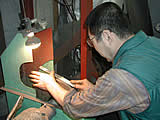
6)Finishing
| 37.E-tuke |
| 37. The haft is heated and pounded into the handle |
| 38.Yugamitori-Kenpin |
| 38. The whole balance is adjusted |
| 39.Bousei-shori |
| 39. It is lubricated with anti rust paint |
| 40.Housou |
| 40. It is packed into the box |